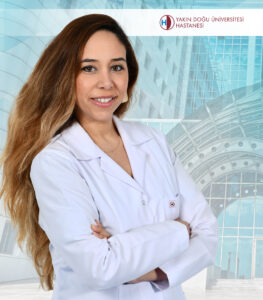
While awareness activities regarding leukemia continue during the Week of Children with Leukemia, Near East University Hospital Department of Child Health and Diseases Specialist Assoc. Prof. Dr. Neşe Akcan shared important information about the symptoms, treatment and risk factors of the disease.
Leukemia, the most common type of cancer in children, constitutes approximately one-third of childhood cancer cases, especially affecting children between the ages of 2-5. The cause of leukemia cases, which are more common in this age group, is the uncontrolled proliferation of cells responsible for blood production in the blood and bone marrow tissue. While leukemia is examined in two main groups, it is stated that 97 percent of childhood leukemias are acute, i.e. rapidly developing types.
Near East University Hospital Department of Child Health and Diseases Specialist Assoc. Prof. Dr. Neşe Akcan emphasized that genetic predisposition is the leading factor causing leukemia and that hereditary immune system disorders and hereditary syndromes increase the risk of the disease. In addition, environmental factors also have an effect on leukemia. Assoc. Prof. Dr. Neşe Akcan states that the risk of leukemia increases in children who have had other cancer treatments in addition to alcohol and cigarette use during pregnancy.

Assoc. Prof. Dr. Akcan stated that leukemia is usually diagnosed with blood tests, bone marrow aspiration and biopsy, and that detailed genetic tests play a critical role in determining the type of leukemia. Symptoms of the disease include fatigue, pallor, headache, fever, easy bruising and bruising on the skin, while in some cases, enlargement of the liver or spleen, loss of appetite, weight loss and swelling of the lymph nodes can also be seen. Assoc. Prof. Dr. Akcan stated that in leukemia treatment, infections are first combated and the general condition of the patient is improved, and that chemotherapy is the main method in leukemia treatment. In cases where high-dose chemotherapy is required, Assoc. Prof. Dr. Neşe Akcan says that bone marrow transplantation or radiotherapy can be added to the treatment, and draws attention to the fact that survival rates in childhood cancers have increased by more than 50 percent compared to the past.
Social support is very important for leukemia patients!
Emphasizing that social support is important for children diagnosed with leukemia and their families, as well as psychiatric support, Assoc. Prof. Dr. Neşe Akcan, Department of Child Health and Diseases Specialist at the Near East University Hospital, said that social support organizations such as LÖSEV in Turkey and Kemal Saraçoğlu Foundation for Children with Leukemia and Fighting Cancer in Northern Cyprus are doing important work in this area. Assoc. Prof. Dr. Akcan emphasized that awareness-raising projects are also of great importance in the fight against leukemia.